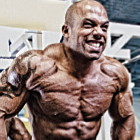There are a couple of tired clichés that apply quite aptly to the goal of long-term bodybuilding gains:
“If you keep doing what you’ve always done, you’ll keep getting what you’ve always got.”
“The definition of insanity is doing the same thing over and over and expecting a different result.”
 The human body is a remarkably adaptive organism. At various times and places humans have adapted to environmental challenges like extremely hot or cold climates, thinner air, arid deserts and very limited diets. So it should come as no surprise that as people train hard with weights for many years, the muscle growth that initially came at a rapid rate when the stress of training was a new shock eventually slows to a crawl. Inevitably, gains will grind to a halt as they finally reach or at least come very close to their ultimate genetic potential.
The human body is a remarkably adaptive organism. At various times and places humans have adapted to environmental challenges like extremely hot or cold climates, thinner air, arid deserts and very limited diets. So it should come as no surprise that as people train hard with weights for many years, the muscle growth that initially came at a rapid rate when the stress of training was a new shock eventually slows to a crawl. Inevitably, gains will grind to a halt as they finally reach or at least come very close to their ultimate genetic potential.
Most trainees, however, probably never get as close to that genetic ceiling as they think they did. The reason is typically that they fall into a pattern—a rut, really—of doing the same workouts over and over, down to the exercises, sets and reps. Some will point to the success of eight-time Mr. Olympia Ronnie Coleman as evidence that you can indeed follow an identical routine for many years and still see progress. Right, but Ronnie also slathered his chicken breasts in KC Masterpiece barbecue sauce when he dieted for the Mr. Olympia, yet he consistently showed up with striated glutes. Following Ronnie’s example and expecting to look the way he did makes about as much sense as using Usain Bolt’s training regimen and thinking you will run 100 meters in 9.58 seconds.
So if you haven’t grown in quite some time—or at least not as quickly as you suspect you should have—the odds are good that you need to change something in your workouts. IFBB Pro Jonathan Delarosa is one of the brightest and hardest-working of the newest generation of pros under the age of 30. At 5’6” and competing at 228 pounds, he would never be accused of lacking mass. In competitive bodybuilding, though “big” is relative, depending on who you’re standing next to onstage. At the New York Pro this past May, he took fourth after new sensation Mamdouh “Big Ramy” Ellssbiay (at 285 pounds), Victor Martinez (240 pounds), and his good friend Juan Morel (250 pounds). A week later at the Toronto Pro, where he was the runner-up in 2012, Jonathan took third to Martinez and runner-up Fouad Abiad, a 260-pounder.
“Judges told me I have a great physique, but these other guys are just bigger and more imposing next to me,” Delarosa said. “I look big, but I want to be so huge that when I walk by, people will say, holy shit! That’s how big those guys are.”
Jon knew he needed more size, but how was he going to get it? The way he’d been training since his teenage years had taken him this far: standard volume of three or four exercises per bodypart, three or four sets each, done for eight to 10 reps. Clearly, it was time to try something else.
“I had always been a fan of Ronnie Coleman, who used higher volume,” he said. “And I have also seen how well more volume and higher reps had worked for my buddy Juan, so I figured I would give it a go.”
Delarosa added more exercises and sets and cranked up the reps into the 15-to-20 range. “The pumps were ridiculous, and the next day I was sore like I hadn’t been in a very long time,” he recalled. He knew he was onto something. A month later he was up eight pounds with no loss in condition, which validated the idea that this particular change in training style would produce results. Jonathan plans to ride this out until the gains stop and then either go back to his standard heavier training or try something different.
If a top pro with gifted genetics like Jonathan Delarosa had to switch up his training to keep the gains coming, it stands to reason that the rest of us genetically average types should be willing and ready to make a change if we hit a sticking point that lasts for more than a few months. Realistically, you should be growing; even if it’s in very tiny increments, every few months. If not you can be sure that your current routine will not produce results. It’s like trying to turn over the engine of a car that has a dead battery. You can sit there and turn that key all day, but you won’t be going anywhere without a jump start or a new battery.
If you’ve been slaving away in the gym for months or even years and your physique looks exactly the same, it’s time to make a change from whatever it is you’re doing. Try new exercises, rep ranges, rep speeds; take shorter rests between sets; do supersets—anything that’s a break from your own status quo. Trust me, you have nothing to lose and—that’s right—everything to gain!
—Ron Harris
Editor’s note: Ron Harris is the author of Real Bodybuilding—Muscle Truth From 25 Years In the Trenches, available at www.RonHarrisMuscle.com.




















You must be logged in to post a comment Login